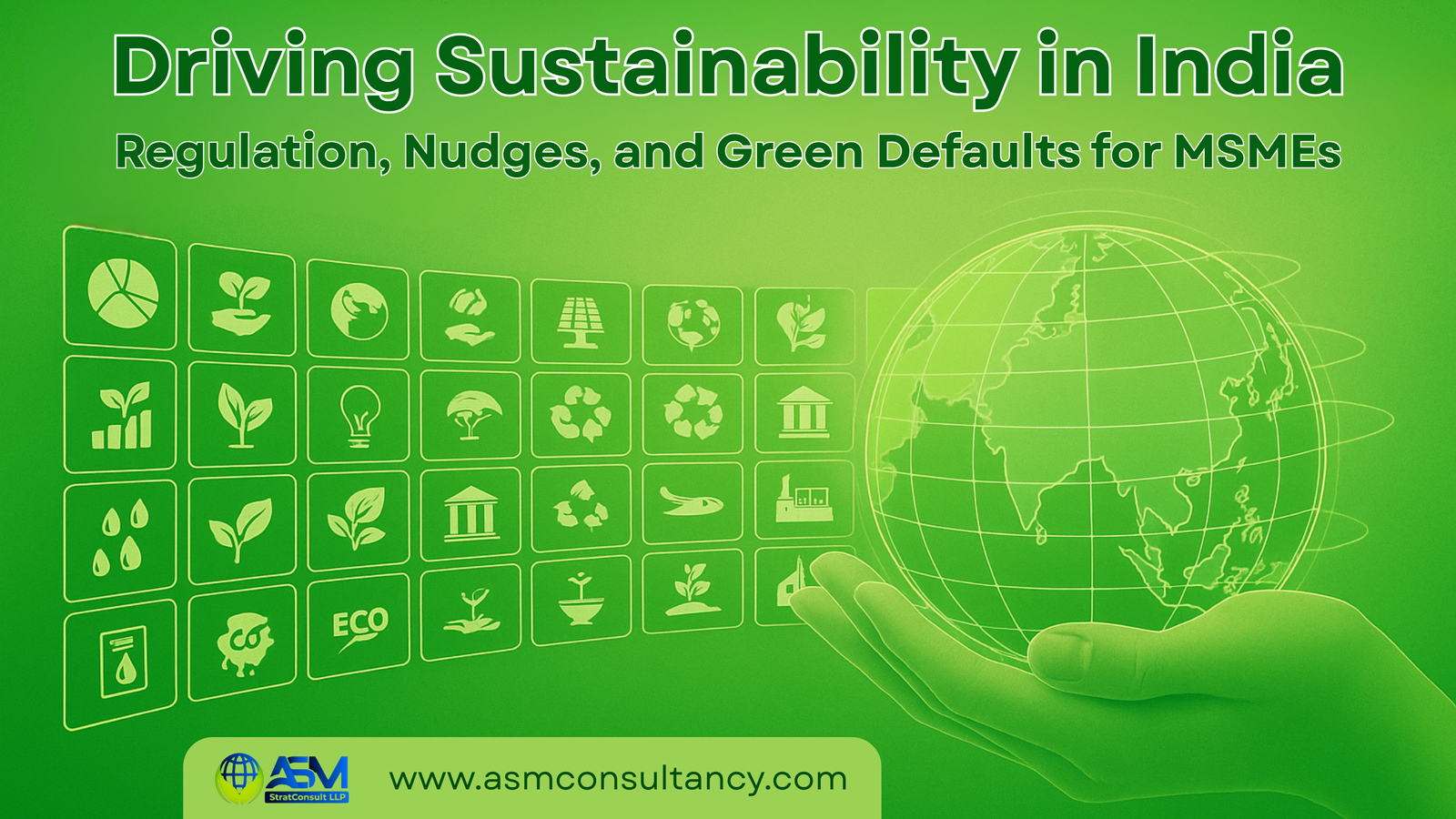By Saptarshi Das
The journey towards sustainability is multi-dimensional. Governments often rely on regulations, such as eco-label mandates, energy efficiency norms, or emissions targets, to guide industries and consumers toward greener practices. While essential, these regulations can be costly to enforce and may provoke resistance—especially among MSMEs, which form the backbone of India’s industrial landscape. In situations like these, behavioural interventions or nudges can be useful.
What are Nudges?
Nudges are easy and low-cost interventions, which are not mandate and people can opt out. This is used to make the target audience perform the desired behaviour and alters people’s behaviour in a predictable way without changing their economic incentives significantly.
The classic example from Thaler and Sunstein: rearranging a snacks counter at a school to keep the healthier snacks at the eye level has increased the consumption of healthier snacks by the students. Some workplaces have their staircases painted in a fun way to influence people to take stairs rather than elevator by which they want healthy lifestyle for the employees.
Here we are not eliminating any options from their choice basket but still we are seeing their choices are not consistent as we are rearranging.
Green Default – A Kind Nudge
Green default is also classified under nudges, where we set the environmentally friendly option as “default”, i.e., the automatic, effortless choice. Although opting out remains possible.
For example:
- Energy providers can enrol customers in renewable energy plans by default.
- Food delivery apps or hotels can make no-plastic cutlery and towel reuse the default option.
Because most users accept defaults, this design creates collective environmental impact with minimal effort. To understand why these subtle shifts in design can be transformative—especially for MSMEs—it’s worth exploring the unique advantages nudges and green defaults bring to the table.
Why Nudges and Green Defaults Matter
- Lower Costs: Reminders, defaults, and social nudges often cost significantly less than enforcement-heavy regulation.
- Greater Adoption: Many stick with default options—making eco-presets (like energy-saving modes or renewable energy plans) powerful tools.
- Habit Formation: Green defaults turn sustainable choices into routine behaviour, embedding them into daily functioning.
Despite these promising initiatives, MSMEs continue to face structural and behavioural barriers. Understanding these challenges is key to designing effective green defaults.
Challenges for MSMEs and How Green Defaults Help
Barriers:
- High upfront costs for sustainable tech.
- Habit inertia and lack of credible alternatives.
- Limited access to technical support and complex regulations.
- Compliance fatigue—especially burdensome for micro and rural firms.
Green Default Solutions:
- Energy-efficient equipment automatically enabled in lease agreements.
- Renewable energy plans bundled as default with business utility contracts.
- Delivery platforms auto-select sustainable packaging or compostable materials.
- Pre-certified eco-label templates or automated disclosure tools to reduce compliance friction.
Behavioural Mechanism in Working
In today’s workplace, sustainability isn’t just a buzzword—it’s a responsibility. One small but impactful change we can make is reducing paper waste caused by one-sided printing. But how do we encourage this shift in behaviour effectively? The answer lies in designing a smart behavioural mechanism using a structured approach.
Step 1: Define the Target Behaviour
The first step is to clearly identify the behaviour we want to change. In this case, it’s the reduction of paper waste due to one-sided printing in office environments. This behaviour is specific, measurable, and actionable—making it ideal for intervention.
Step 2: Understand Barriers
To influence behaviour, we must first understand what’s stopping people from making the change:
- Status Quo Bias: Most office printers default to single-sided printing. Changing settings feels like an unnecessary hassle.
- Perceived Complexity: Employees often find it confusing or time-consuming to switch to double-sided printing.
- Lack of Awareness: Many are unaware of the environmental impact of paper use or underestimate their individual contribution.
These barriers keep people anchored to inefficient habits. But with the right design, we can overcome them.
Step 3: EAST Framework for Intervention Design
The EAST Framework—Easy, Attractive, Social, Timely—is a powerful tool for behavioural design. Here’s how it can be applied:
- Easy: Make the desired behaviour effortless. Set double-sided printing as the default on all office printers.
- Attractive: Use visual cues and incentives.
- Display the CO₂ footprint saved per print job.
- Show how many trees are preserved by choosing double-sided printing.
- Social: Leverage social norms.
- Share stats on how many team members have adopted the practice.
- Recognize departments with the highest adoption rates.
- Timely: The nudge should occur at the decision point—when the printing choice is made—not weeks earlier.
Step 4: Measure and Scale
Once the mechanism is in place, test its impact using A/B testing or randomized trials. If results are promising, scale the initiative across the organization.
When Regulation Falls Short—and Nudges Succeed
- Clean Cooking (LPG Adoption)
Even with the Pradhan Mantri Ujjwala Yojana (PMUY), sustained adoption remained low in some regions. Regulations alone were not enough—nudges like peer-led campaigns or default subsidies were vital. - SSI Regulations Burden MSMEs
Some sectors face 600+ regulations per month, overwhelming small units. Nudges like streamlined licensing defaults or embedded compliance simplify rather than smother small businesses. - Regulatory Complexity vs. Nudge Simplicity
Less than 5% of MSMEs engage in clean-tech R&D, and many face technical support hurdles. Behavioural tools like pre-loaded disclosure templates can ease adoption.
Recent Indian Policies Where Nudges Complement Regulations
- ADEETIE Scheme for MSMEs
Provides technical help and financial support to cut energy use by 30–50% in clusters like pharmaceuticals, glass, and food processing. Coupled with nudges (e.g., default energy audits), adoption can be accelerated. - RAMP Sub-Schemes for MSMEs
- MSME GIFT: credit and guarantee support for green tech.
- MSE SPICE: subsidies for circular economy investments.
- Free ZED certification for women-led enterprises.
Adding nudges like auto-enrollment or default recognition badges can make participation seamless.
- Mission LiFE
Encourages eco-friendly lifestyles through repeatable actions. Example: BEE’s Standards & Labelling Program, nudging consumers to choose energy-efficient products.
Why Combine Regulation with Nudges?
Regulations set the framework and standards for sustainability. Nudges—especially green defaults—amplify impact by turning rules into effortless routines.
For MSMEs, this means:
- Lower compliance costs
- Better market competitiveness
- Readiness for future mandates
- Gradual behavioural shifts without disrupting operations
The Bottom Line
Effective sustainability in India requires both robust regulation and smart behavioural design. By making green choices the effortless default, especially in energy, compliance, and labels, policymakers can help MSMEs transition without overburdening them.
In the end, the biggest leap toward a greener future might just begin with the simplest default.
Sources:

